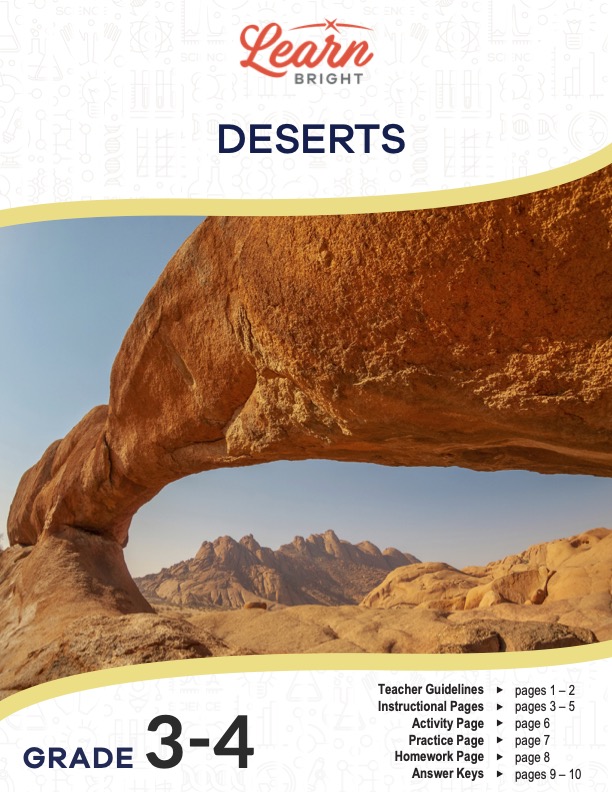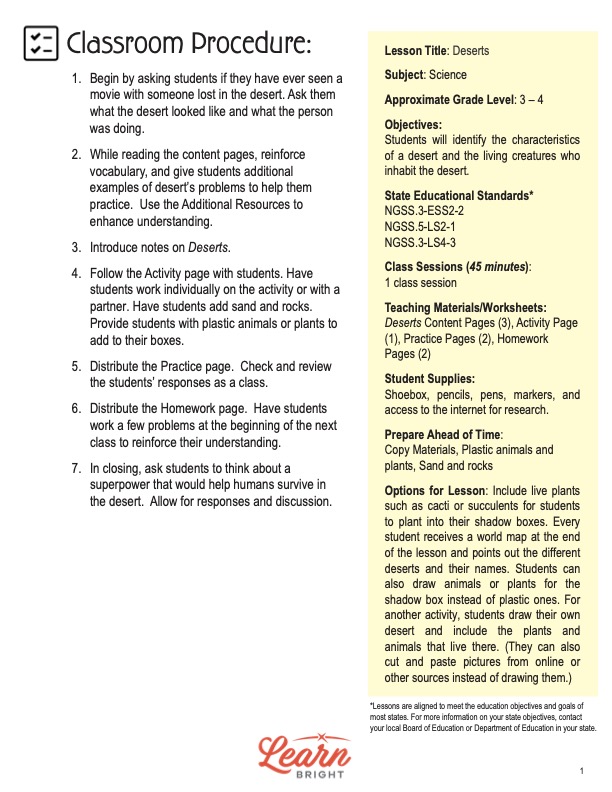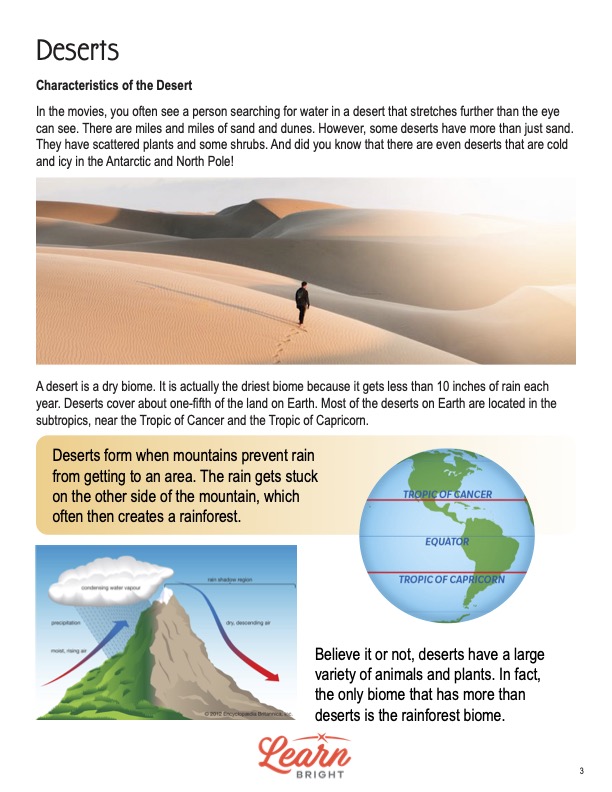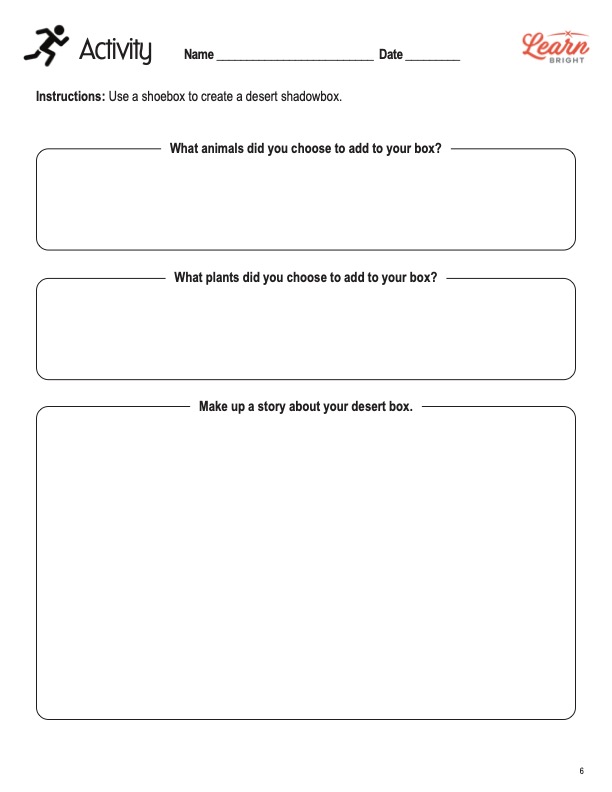Description
What our Deserts lesson plan includes
Lesson Objectives and Overview: Deserts teaches students about the dry and usually hot terrain of the desert landscape. Students will be able to identify some of its traits and discuss the wildlife that live in these areas. By the end of the lesson, students should be able to explain what a desert is like and what to expect from one. This lesson is for students in 3rd grade and 4th grade.
Classroom Procedure
Every lesson plan provides you with a classroom procedure page that outlines a step-by-step guide to follow. You do not have to follow the guide exactly. The guide helps you organize the lesson and details when to hand out worksheets. It also lists information in the yellow box that you might find useful. You will find the lesson objectives, state standards, and number of class sessions the lesson should take to complete in this area. In addition, it describes the supplies you will need as well as what and how you need to prepare beforehand.
Options for Lesson
The classroom procedure page contains an “Options for Lesson” section that provides you with more ideas for additional activities or tasks you could incorporate into the lesson. In this case, one suggestion is to include live plants, such as cacti or succulents, that students could plant in their shadow boxes for the activity portion of the lesson. Another idea is to have students draw animals or plants for the boxes rather than using plastic ones. If you think of other fun ideas, feel free to use those as well throughout the lesson. For instance, you might invite an expert in the field to come speak with the class and answer their questions regarding life in the deserts of the world.
Teacher Notes
There is an extra paragraph of information on this page. It suggests taking advantage of students’ interest and curiosity to make the most of their experience as you teach the lesson. You may choose to teach this lesson in conjunction with others that relate to habitats or animals. Use the blank lines on this page to write down any other thoughts you have before presenting the lesson to your students.
DESERTS LESSON PLAN CONTENT PAGES
Desert Traits
The Deserts lesson plan has three pages of content. The first page provides some background information on deserts in general and their common traits. The lesson starts out by describing the common view of deserts that students may have seen in movies. They often see a person searching for water in a desert that stretches for miles, as far as they can see. There are miles and miles sand dunes everywhere.
However, not all deserts are covered in sand. Students will learn that many deserts have plants and shrubs scattered around. There are even some deserts that are very cold and icy. In fact, the largest desert in the world is actually cold, not hot—the Antarctic. (Students will be able to learn more about this desert while completing the practice worksheet, when they will research the top 10 largest deserts in the world).
What makes a desert a desert is the fact that it is a dry biome. It is the driest biome because it receives fewer than 10 inches of rain each year. Deserts cover around 20% of the land on Earth. Most of them are in the subtropic areas, near the Tropic of Cancer and the Tropic of Capricorn.
The reason these regions form is that mountains prevent rain from getting into the area. The rain gets stuck on one side of the mountain, which often creates a rainforest. Despite the lack of water, there are a large variety of animals and plants that live in these regions. The only habitat that boasts more species of animals and plants is the rainforest.
Hot Deserts
There are two types of deserts: hot and cold. Cold ones don’t really receive rain; instead, they experience fog or snow. Hot deserts receive under 10 inches of rain per year. They have extreme heat during periods of excessive dryness. However, they can get very cold at night. When it rains, the ground is often too hard to absorb any of the moisture. As a result, these areas can experience floods. And occasionally, the habitat is so hot that, when it does rain, the water evaporates before it ever reaches the ground!
The largest hot deserts in the world are spread throughout the world. They include the Sahara, Gobi, Kalahari, Great Victoria, Great Sandy, Chihuahuan, Great Basin, Mojave, and Sonoran. (This is not the list of top 10 largest deserts. You may need to inform students of this to avoid any confusion when they begin to work on their practice worksheet.) The lesson shows students pictures of these deserts. You may find it useful to point out how diverse desert features can be.
Wildlife
While some deserts seem to have no wildlife, neither plants nor animals, many others are full of both. Many people think of snakes and cacti when they think of deserts, but there are so many more species of wildlife than just those. Animals have found innovative ways to adapt and survive in the dry climate of these regions.
Some animals come out only at night and remain under rocks or in cracks during the day to hide from the extreme heat. Such animals are nocturnal. Other animals can live for long periods without having to drink water. In the Sonoran desert, for instance, kangaroo rats can get water from eating seeds. Other animals get water by eating their prey.
The lesson describes three specific animals: the deathstalker scorpion, thorny devil, and camel. The deathstalker scorpion lives in the Sahara and can get as long as 10 centimeters. Despite the species’ scary name, its venom is not actually fatal.
The thorny devil is a type of lizard that has spikes all over its body. These spike protect it against its predators. Students will discover a really cool fact about this lizard: any water that lands on it can funnel into its mouth due to very tiny holes on its body! Camels have adapted very well to their desert life. They have two rows of eyelashes to protect their eyes from dust. Their nostrils are shaped in such a way that they do not inhale sand. And, of course, the camel is famous for its hump, which store fat so that the animal can go a long time without eating food.
Other animals include foxes, spiders, antelopes, gazelle, lions, and elephants. Plants are an excellent source of food for many of these animals. But plants need water to live as well, so they have likewise adapted to the environment so that they can collect and store water to survive. Desert plants have short roots that catch the little bit of water that hits the ground each year.
DESERTS LESSON PLAN WORKSHEETS
The Deserts lesson plan includes three worksheets: an activity worksheet, a practice worksheet, and a homework assignment. Each of these handouts will help students solidify what they learned throughout the lesson plan in different ways. The guidelines on the classroom procedure page outline when to hand out each worksheet to your students.
SHADOWBOX ACTIVITY
For this activity, you can have students either work alone or with a partner. You could also have them work in groups if you choose. For the activity, students will create shadow boxes that display a desert landscape. They will use sand, rocks, and other items, such as plastic animals or plant figures. As the “Options for Lesson” section mentions, they could also draw pictures of animals instead. The worksheet lists two questions for students to answer after they finish their boxes regarding their reasoning for including the animals and plants that they chose. In addition, they will use the blank space at the bottom to write a short story about their box.
RESEARCH ANIMALS PRACTICE WORKSHEET
For the practice worksheet, students will research two animals and a plant that live in the desert. They will draw or glue a picture in the blank box next to the names. Then they will write one way that the animal or plant has adapted to life in the driest biome of the world. If you want, you could add other animals and plants to this list to extend the assignment.
DESERTS HOMEWORK ASSIGNMENT
The homework assignment requires students to fill out a table by listing the world’s 10 largest deserts. Students will add the square-mile area for each one in the column on the right. Then they will write three fun general facts about deserts at the bottom of the page. They may pull from information they learned in the lesson or from their own personal research on the topic.
Worksheet Answer Keys
The final pages of this document are answer keys for the practice and homework worksheets. For the practice answer key, students responses may vary quite a bit. Because they will be researching on their own, you may need to verify some of their responses. Similarly, the three fun facts students find for the second section of the assignment will likely vary as well. However, their list of largest deserts should match that on the answer key. If you choose to administer the lesson pages to your students via PDF, you will need to save a new file that omits these pages. Otherwise, you can simply print out the applicable pages and keep these as reference for yourself when grading assignments.










